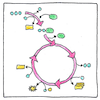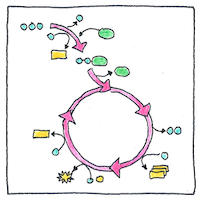Hans Adolf Krebs
metabolism

|
Citric-acid cycle
In living cells, citric acid is consumed and then regenerated in a cycle of reactions that generates energy from the food you eat in the form of adenosine triphosphate. Cellular metabolism in animals doesn’t just break down carbs, fats, and proteins, but synthesizes complex molecules. Hans Krebs discovered the citric-acid cycle using Otto Warburg’s manometer, a laboratory device that collects waste products from tissue samples.
Metabolic confusion
Warburg’s manometer measures intercellular respiratory gases of tissue samples subjected to varying conditions. Studying cellular metabolism, Krebs was confused by conflicting results until he realized animal cells produce energy in a cycle of eight reactions starting and ending with citric acid.
He thought he was lucky
Having worked as Warburg’s assistant at the Kaiser Wilhelm Institute for Biology, Krebs was dismissed from his position as a medical assistant at the University of Freiburg because he was a Jew. He left Germany in 1933 with thirty manometers and was welcomed by Cambridge University and the University of Sheffield where he became the head of the biochemistry department and the director of the research unit for cell metabolism of the Medical Research Council.
Path of life
The citric-acid cycle is common to all organisms that live in an oxygenated environment, and is likely to have been one of the earliest metabolic pathways supporting life on earth. As natural as eating and breathing, common to yeast, aerobic bacteria, and animal cells, it is more common than yawning, scratching, or blinking, even more common than selfishness or stupidity.



Different processes break down carbohydrates, fats, and proteins into chemicals that are taken up by the citric-acid cycle in the mitrochondria of cells. Mitochondria have their own genomes, separate from the genomes of the cell nucleus, which are similar to the genomes of bacteria. This supports the hypothesis that mitochondria originated by incorporating bacterial cells.
See also in The book of science:
Readings in wikipedia:
Other readings: